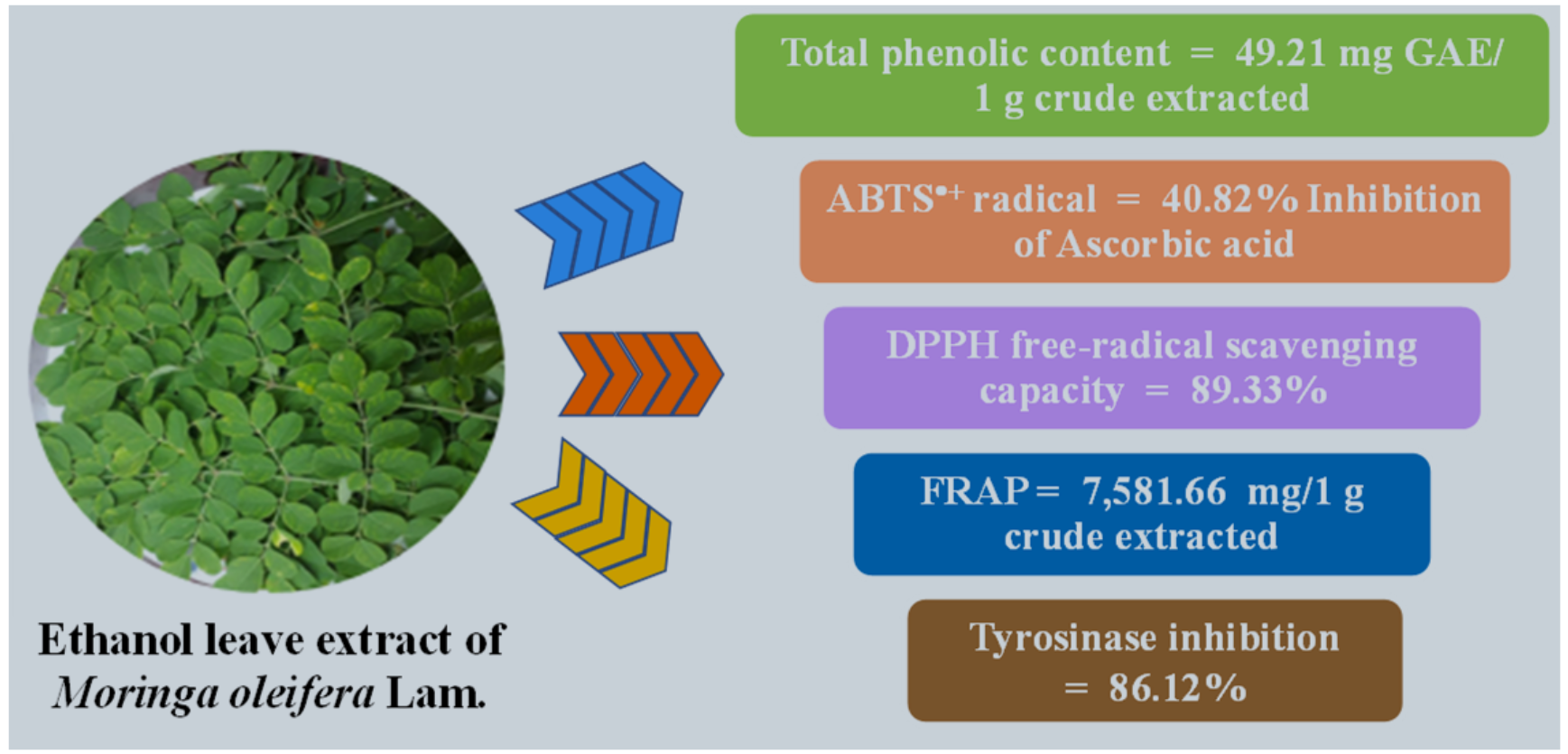The Study of Free radical Scavenging, Total Phenolic Contents, and Tyrosinase Inhibition Activity of Crude Extract from Moringa oleifera Lam.
DOI:
https://doi.org/10.55674/cs.v15i1.241942Keywords:
antioxidant, phenolic compound, Moringa oleifera Lam, tyrosinase inhibitionAbstract
This research studied free radical scavenging capacity, total phenolic content, and tyrosinase inhibition activity from leaves, pods, and seeds of Moringa (Moringa oleifera Lam) extracts. The percentage inhibitions for DPPH assay for ethanol leave extract, methanol leave extract, water leave extract, methanol seed extract, and methanol pod extract were 89.33, 84.05%, 74.85%, 89.09%, and 86.36%, respectively. antioxidant activity phenolic contents the highest value of total The antioxidant activity of the crude products was tested by the ABTS method showing of 40.82% for ethanol extract of the leaves. The ferric-reducing antioxidant power of the crude extract was tested by the FRAP technique to give the ability to reduce Fe3+ to Fe2+ of 7,581.60 mg g1 of the crude extract. The ethanol leaves extract provides the of 49.21 mg GAE g1. The percentages of tyrosinase inhibition activity of ethanol extract of the leaves showed the highest activity of 86.12%. The preliminary findings reveal that ethanol the leaves ethanol extracts have the potential to be used as a natural skinwhitening agent in cosmetic products. In this study, the ethanol leaves extract can be applied as an ingredient in cosmetic products including soap, facial cleansing gel, and cream formulated from the ethanol leaf extract of Moringa. Moreover, the Moringa soap product already passed the specification recommended by the food and drug administrations.
References
F. Apone, A. Baebulova, and M.G. Colucci. Plant and microalgae derived peptides are advantageously employed as bioactive Compounds in Cosmetics. Front. Plant Sci. 10 (2019) 1 − 8.
B. Moyo, P.J. Masika, A. Huga, and V. Muchenje. Nutritional characterization of moringa (Moringa oleifera Lam.) leaves. African Journal of Biotechnology. 10(60) (2011) 12925 − 12933.
A. R. Verma, M. Vijaykumar, C. S. Mathela, and C. V. Rao. In vitro and in vivo antioxidant properties of different fractions of Moringa olifera leaves. Food Chem Toxicol. 47(9) (2009) 2196 − 2201.
C. Rodríguez−Pérez, R. Quirantes−Piné, A. Fernández−Gutiérrez, A. Segura−Carretero, and C. Rodrigu. Optimization of extraction method to obtain a phenolic compounds rich extract from Moringa olifera Lam leaves. Ind Crop Prod. 66 (2015) 246 − 254.
S. Biswas, A. Chowdhury, J. Das, A. Roy, and S.M. Zahid Hosen. Pharmacological potentials of Moringa oleifera Lam. : a review. Int. J. Pharm. Sci. 3(2) (2012) 305 − 310.
M.M. Rahman, M.M.I. Sheikh, S.A. Sharmin, M.S. Islam, M.A. Rahman, M.M. Rahman, and M. F. Alam. Antibacterial activity of leaves juice and extracts of Moringa oleifera Lam. against some human pathogenic bacteria. CMU. J. Nat. Sci. 8(2) (2009) 219 − 226.
S. Luqman, S. Srivastava, R. Kumar, A.K. Maurya, D. Chanda. Experimental assessment of Moringa oleifera leaves and fruit for its antistress, antioxidant, and scavenging potential using in vitro and in vivo assays. Evid. Based Complement Alternat Med. 2012 (2012) 519084.
C.J. Dillard and J.B. German. Phytochemicals :nutraceuticals and human health :A review. J. Sci. Food Agric. 80 (2000) 1744 − 1756.
P. Siddhuraju and K. Becker. Antioxidant properties of various solvent extractions of total phenolic constituents from three different agro-climatic origins of drumstick tree (Moringa olifera Lam.). J. Agric. Food Chem. 15 (2003) 2144 − 2155.
M.C.P. Estrella, J.B.V. Mantaring, and G.Z. David. A double blind, randomized controlled trial on the use of malunggay (Moringa olifera Lam.) for augmentation of the volume of breastmilk among non−nursing mothers of preterm infants. Phillipp. J. Pediatr. 49 (2000) 3 − 6.
K.T. Mahmood, T. Mugal, and I.U. Haq. Moringa olifera : a natural gift – a review. J. Pharm. Sci Res. 2 (2010) 775-781.
J.N. Kasolo, G.S. Bimenya, L. Ojok, J. Ochieng, and J.W. Ogwal-Okeng. Phytochemicals and uses of Moringa oleifera leaves in Uganda rural communities. J. Med. Plants Res. 4 (2010) 753 − 757.
C.R Pérez, R.Q. Piné, A.F. Gutiérrez, and A.S. Carretero. Optimization of extraction method to obtain a phenolic compounds-rich extract from Moringa oleifera Lam leaves. Ind. Crops Prod. 66 (2015) 246 − 254.
M.S. Blios. Antioxidant determinations by the use of a stable free radical. Nature. 26 (1958) 1199 – 1200.
I.F.F. Benzie and J.J. Strain. The ferric reducing ability of plasma as a measure of antioxidant power: The FRAP assay. J. Anal. Biochem. 293 (1996) 70 − 76.
E.A. Shalaby and S.M.M. Shanab. Antioxidant compounds, assays of determination and mode of action. Afr. J. Pharm. Pharmacol. 7(10) (2013) 528 − 539.
R. Re, N. Pellegrini, A. Proteggente, A. Pannala, M. Yang, C. Rice−Evans. Antioxidant activity applying an improved ABTS radical cation decoloriation assay. Free Radic Biol. Med. 9(10) (1999) 1231 − 1237.
A.A. Boligon, M.M. Machado, and M.L. Athayde. Technical Evaluation of Antioxidant activity. Med. Chem. 4(7) (2014) 517 − 522.
M. Skerget, P. Kotnik, M. Hadolin, A.R. Hras, M. Simonic, and Z. Knez. Phenols, pro−anthocyanidins, flavones, and flavonols in some plant materials and their antioxidant activities. Food Chem. 89 (2005) 191 − 198.
S. Muang−Ngam, S. Phasuk, and P. Takonpakdee. Efficiency of naringi crenulata (roxb.) nicolson and coix iacryma-jobi linn crude extracts for tyrosinase inhibition. RMUTP Research J. 21(3) (2015) 69 − 78.
C. Wijaya, B. Elya, and A. Yanuar. Study of Tyrosinase Inhibitory activity and phytochemical screening of Cassia Fistula L. Leaves. Int. J. Appl. Pharm. 10 (2018) 384 − 387.
Y. Wang, Y. Gao, H. Ding, S. Liu, X. Han, J. Gui, and D. Liu. Subcritical ethanol extraction of flavanoids from Moringa oleifera leaves and evaluation on of antioxidant activity. Food Chem. 218 (2017) 152 – 158.
A. Leone, G. Fiorillo, F. Criscuoli, S. Ravasenghi, L. Santagostini, G. Fico, A. Spadafranca, l. Battezzati, A. Schiraldi, F. Pozzi, S. Lello, S. Filippini, and S. Bertoli. Nutritional characterization of phenolic profiling of Moringa Oleifera leaves grew in Chad, Sahrawi refugee camps, and Haiti. Int. J. Mol. Sci. 16 (2015) 12791 − 12835.

Downloads
Published
How to Cite
Issue
Section
Categories
License
Copyright (c) 2022 Creative Science

This work is licensed under a Creative Commons Attribution-NonCommercial-NoDerivatives 4.0 International License.








